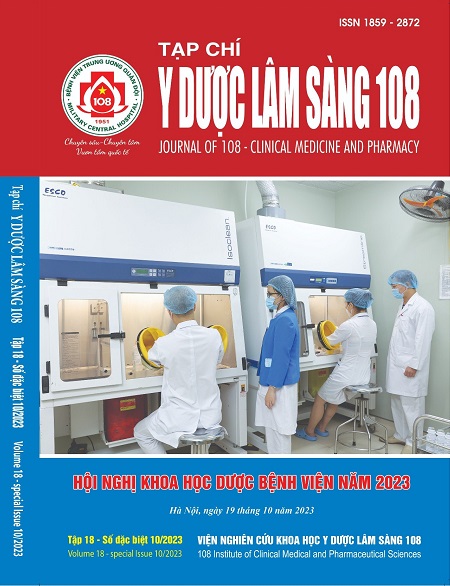Analysis of the probability of achieving PK/PD targets with different dosing regimens of imipenem in neonatal patients at National Hospital of Obstetrics and Gynecology
Main Article Content
Keywords
Abstract
Objective: The aim of this study is to analyze the probability of achieving PK/PD targets of various imipenem dosing regimens for optimizing dosing in neonatal patients at the Neonatal Care and Treatment Centre in the National Hospital of Obstetrics and Gynecology. Subject and method: Clinical dosing regimens, stated dosing regimens on product leaflets and sensitivity levels of target bacteria to imipenem in the neonatal patient population were collected. The percentage of achieving PK/PD targets for different imipenem dosing regimens was then simulated using the Monte Carlo simulation, based on previously published models and microbiological characteristics at the National Hospital of Obstetrics and Gynecology in neonatal patients. PK/PD targets of 40% T > MIC and 100% T > MIC were selected for probability of target attainment (PTA) calculations. Cumulative fraction of response (CFR) based on the distribution of MIC in the bacterial population were calculated to propose appropriate dosing regimens. Dosing regimens were considered therapeutically effective when PTA ≥ 90% and CFR ≥ 80%. Result: 96% of the bacteria in the study population remained sensitive to imipenem, with MIC primarily at 0.19mg/l. For the 40% T>MIC target, all dosing regimens achieved PK/PD target attainment at MIC ≤ 2mg/l. For the 100% T>MIC target, dosing regimens of 35mg q12h, 25mg q8h, and 25mg q6h covered MICs up to ≤ 0.25mg/l, 1mg/l, and 2mg/l, respectively. Regarding the 40% T > MIC target, all surveyed dosing regimens achieved therapeutic effectiveness (CFR ≥ 80%) for MIC50, MIC90, and the entire target bacterial population. For the 100% T > MIC target, dosing regimens of 30mg q12h, 35mg q12h, 25mg q8h, and 25mg q6h all achieved therapeutic effectiveness (CFR ≥ 80%) covering 50% and 90% of the target bacterial population. To achieve 100% coverage of the gram-negative bacterial population, only dosing regimens of 25mg q8h and 25mg q6h were effective. Conclusion: The study demonstrates the probability of achieving PK/PD targets for various dosing regimens using Monte Carlo simulation. Dosing regimens of 25 mg q6h and 25 mg q8h are recommended based on the current microbiological characteristics at the hospital, providing 100% coverage of the target bacterial population in neonatal patients at the National Hospital of Obstetrics and Gynecology.
Article Details
References
2. Gijsen M, Vlasselaers D et al (2021) Pharmacokinetics of antibiotics in pediatric intensive care: Fostering variability to attain precision medicine. Antibiotics (Basel) 10(10).
3. Dao K, Fuchs A, André P, Giannoni E, Decosterd LA, Marchetti O, Asner SA, Pfister M, Widmer N, Buclin T, Csajka C, Guidi M (2022) Dosing strategies of imipenem in neonates based on pharmacometric modelling and simulation. J Antimicrob Chemother 77(2): 457-465.
4. Cục Quản lý Dược - Bộ Y tế (2022) Tienam 500mg/500mg", Retrieved 17/03/2022, from https://drugbank.vn/thuoc/Tienam-%28co-so-san-xuat-va-dong-goi-cap-1:-Merck-Sharp---Dohme-Corp%3B-dia-chi:-2778-South-East-Side-Highway--Elkton--Virginia-22827--USA%29&GC3-1-18.
5. Clinical and Laboratory Standards Institue (2018), M100: Performance Standards for Antimicrobial Susceptibility Testing. CLSI supplement M100.
6. Mouton JW, Dudley MN et al (2005) Standardization of pharmacokinetic/ pharmacodynamic (PK/PD) terminology for anti-infective drugs: An update. J Antimicrob Chemother 55(5): 601-607.
7. American Society of Health-System Pharmacists (2011) AHFS drug information.
8. Ariano RE, Nyhle´n A, Donnelly JP et al (2005) Pharmacokinetics and pharmacodynamics of meropenem in febrile neutropenic patients with bacteremia. Ann Pharmacother 39: 32-8.
9. Bradley JS, Garau J et al (1999) Carbapenems in clinical practice: A guide to their use in serious infection. Int J Antimicrob Agents 11(2): 93-100.
10. Vinks AA, Mouton JW et al (2014) Fundamentals of antimicrobial pharmacokinetics and pharmacodynamics. © Springer Science+Business Media New York. DOI 10.1007/978-0-387-75613-4_11.
11. Bradley JS, Garau J et al (1999) Carbapenems in clinical practice: A guide to their use in serious infection. Int J Antimicrob Agents 11(2): 93-100.
 ISSN: 1859 - 2872
ISSN: 1859 - 2872
